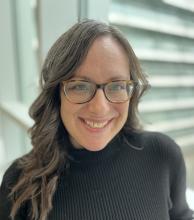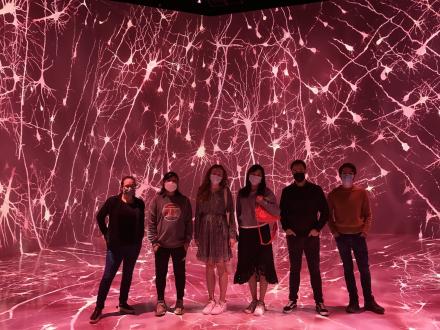
Cell Biology of Neurons, Muscle and Glia; Integrative Neuroscience; Neural Development and Plasticity; Neurological Disorders; and Synapses and Circuits
Dr. Ariel Levine went to Brandeis University for undergraduate studies and graduated in 2000. She then went to the Tri-Institutional MD-PhD program and earned a PhD from The Rockefeller University in 2008 and an MD from Cornell University in 2009. During her graduate research with Dr. Ali Brivanlou, she studied the role of TGF-B signaling during embryonic development. She then did postdoctoral research with Dr. Samuel Pfaff at The Salk Institute, where she identified a novel population of spinal neurons that encode motor synergies ‒ modular neural programs for simple movements that are thought to underlie a wide variety of common behaviors. Ariel joined NINDS as an Earl Stadtman tenure-track investigator in 2015 and became a tenured Senior Investigator in 2024 and leads the Spinal Circuits and Plasticity Section.
Research Interests:
The breadth of animal movements is mesmerizing. From the mountain goat’s nimble adaptive locomotion to the precision pounce of a cougar, and from the acrobatic parkour of squirrels to the delicate handling by racoons, how are such feats accomplished? The answers to this question are distributed throughout the nervous system and the body as a complex interaction of neural coding and biomechanics. But since the work of Sherrington and others over the last century, we know that the mammalian spinal cord can autonomously mediate simple behaviors such as walking, jumping, and limb withdrawal. We seek to define the roles of spinal neurons in selecting, executing, and linking together the elemental movements that can be built up into these behaviors. If spinal motor control is the final output of the mammalian nervous system, then understanding its mechanisms will provide fundamental insights into the neural logic of behavior.
We are guided by three key questions:
What are the cell types of the mammalian spinal cord? Using single nucleus RNA sequencing, we established the first molecular and cellular atlases of the adult spinal cord in both mouse and human. This work identified different organization of the dorsal and ventral regions of the spinal cord, revealed novel populations, and serve as an important references for our field. We've used similar techniques to probe cell-type specific changes in response to spinal cord injury, revealing spinocerebellar neurons that can regrow after contusion injury and neurons that support the recovery of locomotion with neuro-rehabilitation therapy.
How do specific spinal cord cell types contribute to behavior? We use mouse genetics, cell type specific viral manipulations, in vivo electrophysiology, and quantitative behavioral analysis to reveal how neuronal populations contribute to movement. We want to know how motor programs are encoded within spinal circuits, whether particular spinal populations contribute specific computations in motor control, and whether we can we relate cell-type connectivity, location, or other cellular features to function.
How are spinal cord cells incorporated into central nervous system-wide circuits for motor control? We want to know how descending pathways from the brain recruit specific spinal cord cells and circuits to enact movements. What are the roles of parallel descending pathways? We found a direct projection from the cerebellum to the spinal cord that is critical for motor behavior. Now, we want to know how spinal circuits can be dynamically recruited by descending pathways in different behavioral contexts.
Lab Members
Current Members
Li Li: Lab Manager & Research Scientist
Fabricio do Couto Nicola: Postdoctoral Fellow
Prasong (Jerry) Mekdara: Postdoctoral Fellow
Brian Roome: Postdoctoral Fellow
Dena Goldblatt: Postdoctoral Fellow
Alex Richardson: Postbaccalaureate Fellow
Postdoctoral, Graduate Student, and Research Fellow Alumni
Ashley Tucker: Postdoctoral Fellow (postdoc 2023-2024) next position: analyst at Defense Intelligence Agency
Ryan Patterson-Cross (research fellow 2019-2020) next position: Computational biologist, University of Cambridge
Kaya Matson: (graduate Student, NIH-Johns Hopkins GPP program 2017-2022) next/current position: Postdoc with Dr. Erika Holzbauer at U. Penn
Anupama Sathyamurthy (postdoc 2016-2020) next/current position: Faculty Fellow at IIST-Bangalore
Postbaccalaureate Fellow Alumni
Yasin Al-Hadid: next position: clinical research assistant
Eugene Kim: next position: MD-PhD student, Baylor University
Isabelle Hua: next position: MD-PhD student, University of Colorado
Stefan Stoica next position: Postbac fellow, NINDS
Courtney Dobrott next position: Graduate student, University of Colorado - Abigail Person lab
Aaron Bickert next position: Postbac fellow, NCI
Anna Ryba next position: Graduate student, Rockefeller University - Vanessa Ruta lab
Join Our Lab
Welcome! We are always looking for motivated, smart people to join our team - whatever your background.
For prospective post-doctoral fellows, please email Ariel (ariel.levine@nih.gov) and include a cover letter, CV, summary of your research accomplishments, and the names and contact information for three references.
For prospective graduate students, there are several programs through which graduate students can join our lab, including the Brown, Johns Hopkins, and Oxford/Cambridge partnerships. If you are interested in rotating or joining the lab, please email Ariel.
Graduate Partnerships Program (GPP)
Brown Neuroscience Graduate Program
Oxford-Cambridge Scholars Program
For prospective MD/PhD students, there are multiple paths to joining the lab. If you are already enrolled in an MD/PhD program and are interested in joining the lab, please email Ariel.
Accelerated MD/PhD Partnership Training Program
For prospective post-baccalaureate students, please apply at the post-bac/IRTA website and email Ariel with a brief description of your research interests.
Post-Baccalaureate Students IRTA
Lab News
July 2024 - Welcome to Alex Richardson and Dena Goldblatt :)
August 2023 - Welcome, Ashley!! We're so glad you're joining us.
March 2023 - We survived the flood! Huge thanks to all of the lab for pulling together through such a tough time.
November 2022 - huge congratulations to Kaya on successfully defending her PhD. It was an amazing body of work and we're so proud of you!!!
August 2022 - Wooohooo! Kaya's SCI paper was just accepted. Look for it soon in Nature Comms.
July 2022 - Congrats to Fabricio on winning the Fellows Award for Research Excellence :)
July 2022 - Welcome to Ava, Yasin, and Enny. And a warm sendoff and thank you to Krystal and Isabelle - we can't wait to see what you do next in your PhD and MD/PhD programs!!
November 2021 - Congrats to Ariel on receiving the NINDS Director's Award for Mentorship!
September 2021 - The harmonized atlas, Fabricio and Isabelle's review, and a collaborative paper with the Courtine lab are all published on the same day :)
January 2021 - Congrats to Fabricio on his F32 grant!!!

Links and Resources
- Single cell database
- Human spinal cord single cell database
- Code and neural network tools
- Tenure Seminar
Selected Publications
2025
Roome, RB; Yadav A; Flores, L; Puarr, A; Nardini, D; Richardson, A; Waclaw, RR; Arkell, RM; Menon, V; Johnson, JE; Levine, A. (2025) Ontogeny of the spinal cord dorsal horn. BioRxiv
2024
Bonev, B; ... Levine, A; ... Nowakowski, TJ. (2024) Opportunities and challenges of single-cell and spatially resolved genomics methods for neuroscience discovery. Nature Neuroscience, 27:2292.
2023
Yadav, A; Matson, KJE; Lee, D; Alkaslasi, MR; Roome, RB; Ward, ME; Phatnani, H; Le Pichon, CE; Menon, V; Levine, AJ. (2023) A reproducible signature of cytoskeletal and ALS-related genes in human motoneurons. Neuron, 6: 3742.
R. Brian Roome and Ariel J. Levine (2023). The Organization of Spinal Neurons: Insights from Single Cell RNA Sequencing. Current Opinion in Neurobiology, 82:102762.
Archana Yadav*, Kaya J.E. Matson*, Li Li, Isabelle Hua, Joana Petrescu, Kristy Kang, Mor R. Alkaslasi, Dylan I. Lee, Saadia Hasan, Ahmad Galuta, Annemarie Dedek, Sara Ameri, Jessica Parnell, Mohammad M. Alshardan, Feras Abbas Qumqumji, Saud M. Alhamad, Alick Pingbei Wang, Gaetan Poulen, Nicolas Lonjon, Florence Vachiery-Lahaye, Pallavi Gaur, Mike A. Nalls, Yue A. Qi, Michael E. Ward, Michael E. Hildebrand, Pierre-Francois Mery, Emmanuel Bourinet, Luc Bauchet, Eve C. Tsai, Hemali Phatnani, Claire E. Le Pichon, Vilas Menon#, Ariel J. Levine# (2023). A Cellular Taxonomy of the Adult Human Spinal Cord. Neuron 111:328 *equal contribution; #co-corresponding.
Gao, C., Gohel, C.A., Leng, Y., Goldman, D., Levine, A.J., Penzo, M.A. (2022) Molecular and spatial profiling of the paraventricular nucleus of the thalamus. eLife 12:e81818
Koch, SC; Levine, AJ. (2023) The Neuronal Cell Types of the Spinal Cord. Spinal Interneurons, Elsevier.
2022
Kathe, C. et al…Matson, K.J.E.;… Levine, A.J., Wagner, F.; Bloch, J.; Squair J.W.; Courtine, G. (2022) The Neurons That Restore Walking After Paralysis. Nature 611:540 doi: 10.1038/s41586-022-05385-7
Matson, K.J.E., Russ, D.E., Kathe, C., Maric, D., Hua, I., Maric, D., Ding, Y., Krynitsky, J., Pursley, R., Sathyamurthy, A., Squair, J.W., Levi, B.P., Courtine, G., and Levine, A.J. (2022). A Single Cell Atlas of Spared Tissue Below a Spinal Cord Injury Reveals Cellular Mechanisms of Plasticity. Nature Communications 13:5628
2021
Do Couto Nicola, F; Hua, I; Levine, AJ. (2021) Intersectional Genetic Tools to Study Skilled Reaching in Mice. Experimental Neurology.
Squair, JW; Gautier, M; Kathe, C; Anderson, MA; James, ND; Hutson, T; Hudelle, R; Qaiser, T; Matson, KJE; Barraud, Q; Levine, AJ; La Manno, G; Skinnider, MA; Courtine, G. (2021) Confronting false discoveries in single-cell differential expression. Nature Communications, 12:5692.
Russ, ED*; Patterson-Cross, RB*; Li, L; Koch, SC; Matson, KJE; Levine, AJ. (2021) A Harmonized Atlas of Spinal Cord Cell Types and Their Spatial Organization. Nature Communications, 12:5722.
Barik, A; Sathyamurthy, A; Thompson, JH; Seltzer, M; Levine, AJ; Chesler AT. (2021) A spinoparabrachial circuit defined by Tacr1 expression drives pain. eLife 10:e61135.
Patterson-Cross, RB; Levine, AJ*; Menon, V*. (2021) Selecting single cell clustering parameter values using subsampling-based robustness metrics. In press BMC Bioinformatics. *co-corresponding.
2020
Skinnider, MA; Squair, JW; Kathe, C; Anderson, MA; Gautier, M; Matson, KJE; Milano, M; Hutson, TH; Barraud, Q; Phillips, AA; Foster, LJ; La Manno, G; Levine, AJ; Courtine, G. (2020) Cell Type Prioritization in Single-Cell Data, Nature Biotechnology.
Sathyamurthy, A; Barik, A; Dobrott, CI; Chesler, AT; Levine, AJ. (2020) Cerebellospinal neurons regulate motor performance and motor learning. Cell Reports, 31: 107595.
2019
Dobrott, CI; Sathyamurthy, A; Levine, AJ. (2019) Decoding Cell Type Diversity Within the Spinal Cord. Current Opinion in Physiology, 8:1-6.
2018
Matson, KJE; Sathyamurthy, A; Johnson, KR; Kelly, MC; Kelley, MW; Levine, AJ. (2018) Isolation of Adult Spinal Cord Nuclei for Massively Parallel Single-Nucleus RNA Sequencing. Journal of Visualized Experiments, 140:e58413.
Sathyamurthy, A*; Johnson, KR*; Matson, KEJ; Li, Li; Ryba, AR; Bergman, TB; Dobrott, CI; Kelly, MC; Kelley, MW; Levine, AJ. (2018) Massively Parallel Single Nucleus Transcriptional Profiling Defines Spinal Cord Neurons and Their Activity During Behavior. Cell Reports, 22: 2216-2225. *equal contribution.
Hayashi, M; Hinckley, CA; Driscoll, SP; Moore, NJ; Levine, AJ; Hilde, KL; Sharma, K; Pfaff, SL. (2018) Graded arrays of spinal and supraspinal V2a interneuron subtypes underlie forelimb and hindlimb motor control. Neuron, 97:869-884.
2012-2016
Hilde, KL; Levine, AJ; Hinckley, CA; Hayashi, M; Montgomery, JM; Gullo, M; Driscoll, SP; Grosschedl, R; Kohwi, Y; Kohwi-Shigematsu, T; Pfaff, SL. (2016) Satb2 is required for the development of a spinal exteroceptive microcircuit that modulates limb position. Neuron, 91:763-776.
Pawar, K; Cummings, B; Thomas, A; Shea, L; Levine, A; Pfaff, S; Anderson, A (2015) Biomaterial bridges enable regeneration and re-entry of corticospinal tract axons into the caudal spinal cord after SCI: association with recovery of forelimb function. Biomaterials, 65:1-12.
Levine, AJ*, Hinckley, CA*, Hilde, KL, Driscoll, SP, Poon, TH, Montgomery, JM, Pfaff, SL (2014) Identification of a cellular node for motor control pathways. Nature Neuroscience, 17:586:593. *equal contribution
Levine, AJ; Lewallen, KA; Pfaff, SL. (2012) Spatial organization of cortical and spinal neurons controlling motor behavior. Current Opinions in Neurobiology, 22:812-21.
